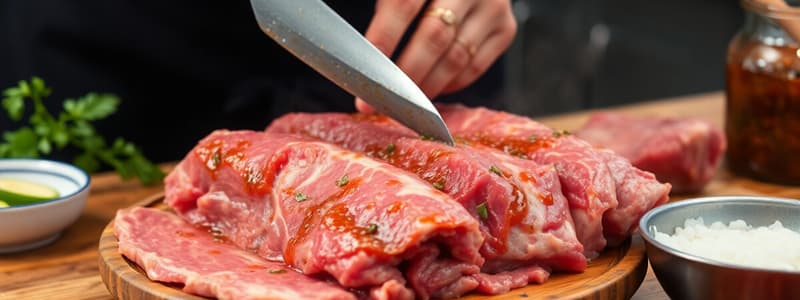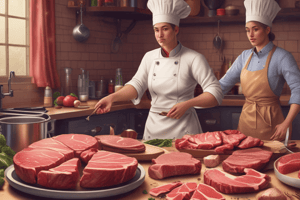Podcast
Questions and Answers
What are marinades? Give the ingredients of a simple marinade that you often use for meat.
What are marinades? Give the ingredients of a simple marinade that you often use for meat.
Marinades are flavored liquids used to soak foods before cooking.
What are your favourite kind of meat dishes? Give at least three (3).
What are your favourite kind of meat dishes? Give at least three (3).
Answers will vary. Examples include steak, roast chicken, and pork chops.
What are the three basic components of a marinade?
What are the three basic components of a marinade?
Acid, oil, and herbs/spices.
Seafood can be marinated for 2 hours up to 2 days.
Seafood can be marinated for 2 hours up to 2 days.
Always reuse marinades.
Always reuse marinades.
High heat tenderizes connective tissue if moisture is present and cooking is slow.
High heat tenderizes connective tissue if moisture is present and cooking is slow.
What are two methods of cooking meat?
What are two methods of cooking meat?
The browning of food through dry heat cooking is called the _____ reaction.
The browning of food through dry heat cooking is called the _____ reaction.
The following are all examples of dry-heat cooking methods except:
The following are all examples of dry-heat cooking methods except:
Forms of dry-heat cooking that use hot, dry air to cook food is known as:
Forms of dry-heat cooking that use hot, dry air to cook food is known as:
Dry-heat cooking methods that rely on heat being conducted through the air from an open flame are:
Dry-heat cooking methods that rely on heat being conducted through the air from an open flame are:
Sautéing requires a very hot pan.
Sautéing requires a very hot pan.
What is a similarity between sautéing and other dry heat cooking methods?
What is a similarity between sautéing and other dry heat cooking methods?
Deep-frying is a form of moist-heat cooking.
Deep-frying is a form of moist-heat cooking.
Cooking temperatures are much lower in moist heat cooking.
Cooking temperatures are much lower in moist heat cooking.
Which description best describes simmering?
Which description best describes simmering?
During boiling, the violent agitation caused by the rolling boil is ideal for food.
During boiling, the violent agitation caused by the rolling boil is ideal for food.
Give an example of moist-heat cooking.
Give an example of moist-heat cooking.
Tenderloin, Ribeye, New York Strip, and T-bone/Porterhouse are all what kinds of cuts?
Tenderloin, Ribeye, New York Strip, and T-bone/Porterhouse are all what kinds of cuts?
Less tender cuts from leg or round are used for braising
Less tender cuts from leg or round are used for braising
Meats high in fat are cooked with added fat to prevent dryness, like sautéing, pan frying or braising.
Meats high in fat are cooked with added fat to prevent dryness, like sautéing, pan frying or braising.
Flashcards
What is a marinade?
What is a marinade?
A marinade adds flavor, tenderizes, and makes meat juicier.
3 Basic Marinade Components
3 Basic Marinade Components
Acid, oil, and herbs/spices.
Why Use Acid in Marinades?
Why Use Acid in Marinades?
It breaks down the meat and tenderizes it.
What is the function of oil in marinades?
What is the function of oil in marinades?
Signup and view all the flashcards
Function of Herbs & Spices in Marinades
Function of Herbs & Spices in Marinades
Signup and view all the flashcards
Marinating time for meat/poultry
Marinating time for meat/poultry
Signup and view all the flashcards
Marinating time for seafood/fish
Marinating time for seafood/fish
Signup and view all the flashcards
Containers to avoid when marinating
Containers to avoid when marinating
Signup and view all the flashcards
Effect of slow cooking with moisture
Effect of slow cooking with moisture
Signup and view all the flashcards
High heat impact on meat
High heat impact on meat
Signup and view all the flashcards
Cooking meat to avoid overcooking
Cooking meat to avoid overcooking
Signup and view all the flashcards
Dry heat cooking
Dry heat cooking
Signup and view all the flashcards
Browning meat
Browning meat
Signup and view all the flashcards
What is Roasting & Baking?
What is Roasting & Baking?
Signup and view all the flashcards
Grilling & Broiling
Grilling & Broiling
Signup and view all the flashcards
Sautéing
Sautéing
Signup and view all the flashcards
Deep Frying
Deep Frying
Signup and view all the flashcards
Moist Heat Cooking
Moist Heat Cooking
Signup and view all the flashcards
Simmering
Simmering
Signup and view all the flashcards
Boiling
Boiling
Signup and view all the flashcards
Study Notes
- Preparing and Cooking Meat
Marinades
- Marinades add flavor and make meat more tender and juicy
- Making a marinade is very simple and comprised of three basic components:
- Acid (e.g., lemon juice, vinegar, yogurt, or wine)
- Breaks down meat and tenderizes it
- Oil
- Protects and preserves food while marinating and cooking
- Herb and/or spice
- Gives a marinade its unique flavor and zest
- Experiment by grouping one or more ingredients from each component
- Acid (e.g., lemon juice, vinegar, yogurt, or wine)
General Guidelines for Marinating
- Meat and poultry are generally marinated for 2 hours up to 2 days
- Seafood and fish should be marinated for no longer than one hour
- Use a non-reactive container, avoiding aluminum, copper, or cast iron
- Cool marinade before pouring over the meat
- Always refrigerate meat while marinating
- Never reuse marinades
Effects of Heat on Meat
- Tenderizes connective tissue if moisture is present and cooking is slow
- Coagulates protein
- Meats low in connective tissue can be tough and dry if cooked at excessively high heats for too long
- High heat toughens and shrinks protein, causing excessive moisture loss
- Roasts cooked at low temperature shrink less and lose less moisture
- Moist heat penetrates meat quickly
- To avoid overcooking, meat should be simmered, never boiled
Methods of Cooking Meat
- Dry heat cooking:
- Roasting
- Broiling
- Sautéing
- Moist heat cooking:
- Braising
- Steaming
- Poaching
Dry Heat Cooking
- Refers to any cooking technique where heat is transferred without using moisture
- Typically involves high heat, with temperatures of 300°F or hotter
- Browning of food (Maillard reaction) can only be achieved through dry-heat cooking
- Examples of dry-heat methods:
- Roasting and Baking: Uses hot, dry air to cook food
- Browns the surface of the food, developing complex flavors and aromas
- Grilling and Broiling: Relies on heat being conducted by air from open flame
- Produces browning reactions
- Encourages the development of complex flavors and aromas
- Sautéing and Pan-Frying: Uses a very hot pan and small amount of fat to cook food quickly
- Browns food's surface as it cooks and develops complex flavors and aromas
- Requires a very hot pan
- Deep-Frying: Submerging food in hot, liquid fat
- Roasting and Baking: Uses hot, dry air to cook food
Moist Heat Cooking
- Includes any technique involving cooking with moisture, such as steam, water, stock, wine, or another liquid
- Cooking temperatures are much lower, from 140°F up to a maximum of 212°F
- Examples of moist-heat cooking methods:
- Simmering: Cooking liquid is a bit hotter than poaching, ranging from 180°F to 205°F
- Bubbles form and gently rise without reaching a full rolling boil
- Cooks food very evenly due to constant temperature
- Excellent choice for culinary preparations including stocks, soups, and starchy items
- Boiling: Water reaches its highest possible temperature of 212°F
- Least likely of the three stages to be used for cooking, as the rolling boil can be too rough on food, often damaging it
- Steaming: Employs hot steam to conduct heat to the food item
- Braising and Stewing: Involves partially covering food in liquid and simmering slowly at a low temperature
- Simmering: Cooking liquid is a bit hotter than poaching, ranging from 180°F to 205°F
Factors Affecting Choice of Cooking Methods in Meat
- Cuts of meat:
- Tender cuts (ribs and loin) are used for roasting, broiling, and grilling
- Less tender cuts (leg or round) are used for braising
- Tougher cuts (chuck or shoulder) are usually braced
- Least tender cuts (shanks, breast, brisket, and flank) are cooked by moist heat
- Ground meat and cubed meat (usually made from trimmings) can be cooked by dry or moist heat
- Fat content:
- Meats high in fat are cooked without added fat (e.g., roasting or broiling)
- Meats low in fat are often cooked with added fat to prevent dryness (e.g., sautéing, pan frying, or braising)
- Desired quality:
- Tenderness isn't the only goal
- To develop flavor and appearance is also one of the objectives to get the desired quality
Studying That Suits You
Use AI to generate personalized quizzes and flashcards to suit your learning preferences.




